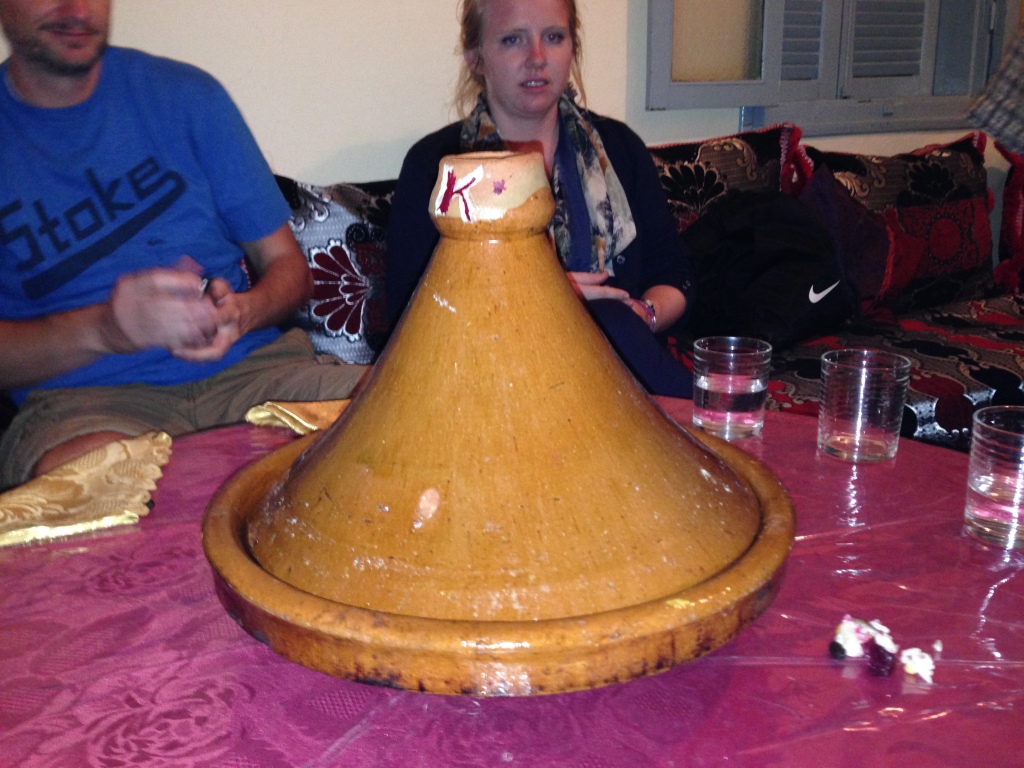Morrocon Tagine Experience at Dar Chebab in Ouled M’Barek Women’s center and Ouaouizeght Boarding School host families.
What is a Tagine?
A tagine is a unique type of ceramic or clay cookware that’s popular in North Africa. The bottom is a wide, circular shallow dish used for both cooking and serving, while the top of the tagine is distinctively shaped into a rounded dome or cone.
The word “tagine” also refers to the succulent dish which is slow-cooked inside the cooking vessel. Typically, a tagine is a rich stew of meat, chicken, or fish, and most often includes vegetables or fruit. Vegetables can also be cooked alone.
Tagines are primarily used to slow-cook savory stews and vegetable dishes. Because the domed or cone-shaped lid of the tagine traps steam and returns the condensed liquid to the pot, a minimal amount of water is needed to cook meats and vegetables to buttery-tenderness. This method of cooking is very practical in areas where water supplies are limited or where public water is not yet available.
The traditional method of cooking with a tagine is to place the tagine over coals. Large bricks of charcoal are purchased specifically for their ability to stay hot for hours. Smaller pieces of charcoal are reserved for cooking brochettes and other grilled meats.
Morrocon hospitality – Home cooked meal
The host welcomes you into their homes with greetings (Salam alaikum and kisses on both cheeks by females, hand shake by men). You remove your shoes at the entrance before entering the living area. The living area is a rectangular room with colorful cushioned seating and round center tables, where food and drinks are served.
A pitcher of water and bowl is brought around the table for the guest to wash their hands before and after the meal.
The females take pride in the presentation of all the prepared meals, and the men take the responsibility of severing the guest and making sure they are satisfied or had enough.
The host families do not eat with the guest. They make sure the guests are well fed.
Tagines are traditionally eaten communally; diners gather around the tagine and eat by hand, using pieces of bread to scoop up meat, veggies and sauce.
One of the rule is to eat from a little imaginary triangle in front of you and not reach over. What a fun experience.
You take your time thru the whole meal. Meals are leisurely event that are not supposed to be rushed.
Meat Tagine being cooked
Diners awaiting the meal.
Hot mint tea and Salad to start the meal.
Main entre – Meat tagine with olives and tomatoes. Use the bread and fingers to pull the meat and put it in the mouth.
OR Couscous tagine with chicken and vegetables.
Roll the couscous with the vegetables in a ball and put it in the mouth. Here is a fun way to eat a meal.
Wrap up the meal with fresh fruit and some more green tea.
What goes into a tagine?
Any meat, any vegetable, although Morrocons are a nation who do not use pork.
Vegetarian Tagine
Try poached eggs in Tomatoes, a sort of Huevo rancheros Moroccan-style? Omelette with Olives and Cumin for breakfast.
The most common spice combination used in tagines
Ginger
Ground comes from the ginger root. It is fragrant and spicy and is used extensively in Moroccan stews, tagines and soups.
Black Pepper
Ground black pepper comes from the small, dried berries of the Piper nigrum plant.
Sweet Paprika
Made from dried sweet red peppers, paprika is used in Moroccan cooking to season meat, cooked salads, bean dishes, some stews and soups.
Cayenne Pepper or Hot Paprika
Like its sweet counterpart, cayenne pepper or hot paprika is ground from dried peppers, although a spicier variety. Its use in Moroccan cooking is mostly optional and to taste.
Cumin
Cumin comes from the dried fruit of a plant in the parsley family. It is very aromatic and imparts a slightly bitter taste. It is used in Moroccan cooking to season eggs, some tagines and stews, grilled and roasted meats, and vegetables.
Cinnamon
is a fragrant, sweet spice which comes from the bark of the cinnamon tree. Moroccan cuisine makes use of both ground cinnamon and pieces of the ground bark (quills, or sticks). Cinnamon is most common in Moroccan pastries and sweeter dishes, such as those that combine meat with fruit.
Saffron Threads
are the cultivated stigmas from the saffron crocus flower. They are very fragrant and only a few threads are needed to impart a yellow color, wonderful aroma and distinctive taste to dishes. Saffron is known to be expensive.
This is a bright orange powder that is used alone or with turmeric to give Moroccan dishes a yellow color. The colorant has no aroma and no taste, and is probably not widely available outside of Morocco. If you use it, watch out—it’s messy!
Turmeric
Although is primarily used to impart a yellow color to Moroccan food, it does have an earthy aroma and slightly bitter taste. It comes from the ground roots of a plant called Curcuma longa. Moroccans frequently use both turmeric and an artificial colorant in a single recipe.
Ras El Hanout
The name translates to “head of the shop” and it’s a mixture of ground spices. vary, but they frequently include cardamom, nutmeg, anise, mace, cinnamon, ginger, various peppers, and turmeric.

